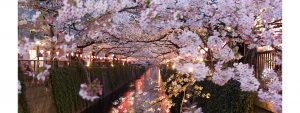Even if you love snow, cold weather, and all things winter, there’s no denying that euphoric sensation you feel when the flowers start blooming and the weather starts warming up. Cultures have celebrated the transition from winter to spring since early civilization. From water fights to massive bonfires, discover what people around the world do to celebrate the vernal equinox.
1. Canadian Tulip Festival

The origins of this festival date back to 1945, when Princess Juliana of the Netherlands presented 100,000 tulip bulbs to Canada to show appreciation for the asylum the members of Holland’s exiled royal family were granted during World War II. The Netherland’s tradition of gifting tulips to Canada continued each year, and the first Canadian Tulip Festival occurred in 1953. Every May, over a million tulips bloom across the National Capital Region, attracting over 500,000 visitors for the world’s largest tulip festival.
2. Las Fallas

Las Fallas is a tradition honoring Saint Joseph in the region of Valencia, Spain. This extensive celebration officially begins on March 1st with a mascletà, a boisterous firework show, which recurs every afternoon through March 19th.
During the final week of the festival, music fills the streets, participants don traditional outfits, and revelers party in the streets until sunrise. In preparation, each neighborhood spends months creating giant, papier-mâché statues (fallas) to display around the city. These fallas usually satirize politics and social customs. On the final night, the fallas are burnt to the ground amidst fireworks.
3. Hanami

Also known as the Cherry Blossom Festival, Hanami is a Japanese tradition to welcome spring and appreciate the beauty of sakura (the Japanese term for cherry blossoms). Sakuras are considered the flower of spring, symbolizing a time of renewal. Depending on the region of Japan you are, events can begin at the beginning of April or in mid-May (in areas like Hakkaido, where sakuras bloom much later).
In celebration, people gather under the blooming cherry blossoms with food, drinks, and music to bond and meet new friends. At night, the trees are illuminated to continue the festivities in a romantic custom called Yozakura.
4. Songkran Festival

The Songkran Festival, which is tied to the Thai New Year, occurs each year in mid-April for three days. It’s a time to clean, reflect, and pay respect to your neighbors, family, and the elderly.
During the festival, people bring food to local monks and bathe Buddha statues in water, while younger Thais pour scented water over the hands of their elders for luck and prosperity. Over the years, this tradition has evolved to include a massive water fight with water balloons and super soakers.
5. Holi Festival

Commonly known as the festival of colors, Holi is a Hindu tradition in India and Nepal that commemorates the end of winter’s gloomy days. This holiday is so sacred that even local markets and businesses are expected to close up shop in preservation.
During the first full moon of March, people light bonfires to celebrate the triumph of good over evil, and then spread the sacred ashes on their foreheads to protect themselves against evil. The following morning, Holi begins. The entire neighborhood comes together and throws colored water and powder on each other in celebration.
6. Nowruz
In Iran, people celebrate Nowruz, meaning “The New Day” in Farsi, over the course of 13 days in March near the vernal equinox. Customs include cleaning, buying new clothes, paying visits to family and friends, and feasting on a symbolic spring meal called Haft seen. On the 13th day, families celebrate with an outdoor picnic to symbolically re-appropriate the bad luck associated with the number 13.
7. Baba Marta Day

In Bulgaria, Baba Marta Day, meaning “Grandma March Day,” celebrates the return of spring on March 1st. According to folklore, “Grandma March” was a snappish old lady who was always grimacing towards her two brothers; but when she did smile, the sun came out.
While there are different versions of the tale, nowadays most Bulgarians wear a small martenitsa adornment, made of white and red yarn, to symbolize their wish for good health and the coming of spring. Bulgarians wear the martenitsa until around the end of the month, when the first signs of spring arrive. Many people then tie their martenitsas to fruit trees for good luck.
The list doesn’t end here! To learn more about other celebrations held around the world, take a peek at 10 Little Known Holidays Around the World.





